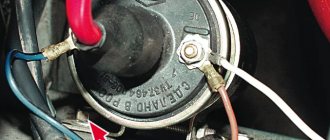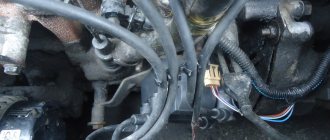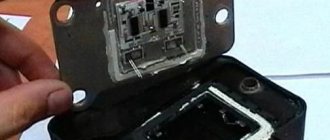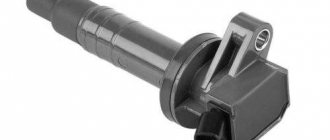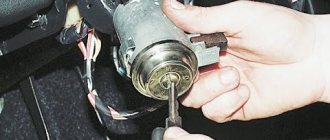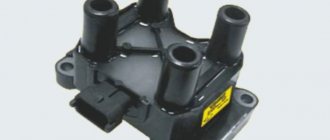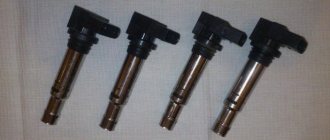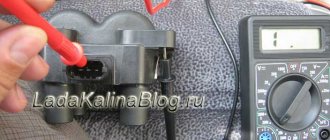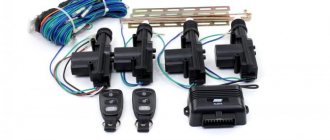On VAZ 2101, 2102, 2103, 2104, 2105, 2106, 2107 cars and their modifications, the B-117A ignition coil is used.
It is installed on the left mudguard of the car's engine compartment on two studs. B-117A ignition coil device
The B-117A ignition coil is a transformer with an open magnetic circuit, which consists of a core and an annular outer magnetic circuit. The core is made of electrical steel plates 0.5 mm thick. The outer magnetic circuit serves to improve the magnetic conductivity of the coil and consists of a 0.3 mm thick electrical steel tape rolled into two and a half layers. To reduce eddy currents it has vertical slots.
The core is housed in a cardboard frame on which is wound a secondary winding containing 55 layers of enamel-insulated copper wire separated by layers of paper. The secondary winding has 50 turns in the first and last layers.
A primary winding is wound on top of the secondary winding, having 48 turns in the first and last layers, and 52 in the rest. The layers of the winding are separated from each other by paper. The primary winding is insulated from the secondary winding with a layer of cardboard.
The end of the secondary winding is connected to the beginning of the primary and brought to the “+B” contact on the coil cover. Electric current comes to it from the ignition switch and energizes the coil windings.
The B-117A ignition coil is filled with transformer oil through a hole in the cover that is closed with a screw. Oil is necessary to cool the windings.
The ignition coil is covered with a cover made of high-voltage plastic (phenoplast). It has a terminal for a high-voltage wire and two other terminals. The “+B” terminal is described above, and the second unnamed terminal is connected to the primary winding.
The terminal for the high voltage wire is connected to a screw, a spiral spring and then to a core which is connected to the terminal of the beginning of the secondary winding (high voltage terminal).
B-117A ignition coil diagram
— In addition to the B-117A, ignition coils 27.3705 and 3122.3705 are installed on the “classic” VAZ.
For a gasoline internal combustion engine, the ignition system is one of the determining ones, although it is difficult to single out any main component in the car. You can’t go without a motor, but it’s also impossible without a wheel.
The ignition coil creates high voltage, without which it is impossible to form a spark and ignite the fuel-air mixture in the cylinders of a gasoline engine.
Ignition coil reliability parameters
Before purchasing a new reel, try to find out its reliability, according to reviews from its owners. Ask about the mileage that the device has withstood, whether the engine response and fuel consumption, maximum speed and CO emissions have changed.
The coil design must ensure:
- reliable insulation between windings and turns;
- high electrical resistance between the body and ground;
- strength of the case, especially plastic parts;
- absence of microcracks;
- reliability of electrical contacts and connections.
A high-quality reel can withstand temperatures up to 180°C.
Types of ignition coils
Ignition coils provide sparking for all spark plugs in turn using distributors. Switched devices include the B-116 ignition coil and its varieties:
- B-114;
- B-115;
- B-117.
Externally, the devices are similar, but have different resistances and inductances of the primary and secondary windings and are intended for use in various ignition systems. For example, B-114 is used in contact systems, and B-116 with contactless transistor distributors. Both coils will work in circuits not intended for them, but not for long.
B-114 and B-117 are similar in structure, but have different terminal designations and winding data. In some cases, their mutual replacement can give a positive result, but setting the ignition using the standard method will not work. We'll have to act on a whim.
The B-114 coil has a three times higher transformation ratio than the others. Therefore, it is advisable to use B-114 in powerful engines running on low-octane fuel, for example:
- ZIL 130, 131;
- GAZ-53, 66, 3102;
- GROOVE;
- KaVZ.
Reel design and operation
The modern bobbin is a simplified version of the Ruhmkorff induction coil. It was named after the German-born inventor Heinrich Ruhmkorff, who was the first to patent a device in 1851 that converts low-voltage direct voltage into high-alternating voltage.
To understand the principle of operation, you need to know the structure of the ignition coil and the basics of radio electronics.
This is a traditional, common VAZ ignition coil, used for a long time and on many other cars. In fact, this is a pulse high-voltage transformer. On a core designed to enhance the magnetic field, a secondary winding is wound with a thin wire; it can contain up to thirty thousand turns of wire.
Characteristics of popular ignition coils
| Ignition coil | Transformation ratio | Design features | Applicability of ignition coils |
| B114-B | 227 | R, M, DR | ZIL-130, 131; GAZ-56, 66, 3102; PAZ, KAvZ |
| B115-V | 88 | R, M, DR | M-412, 2140, 2141; GAZ-24; ZAZ-968 and others. |
| B116 | 153 | R, M, DR | GAZ-2410, 31029 |
| B117 | 78.5 | R, M | VAZ-2101,…07, 2121 |
| B118 | 115 | R, M, E, DR | ZIL-131; GAZ-66, etc. |
| 27.3705 | 82 | R, M | VAZ-2104,...09, 2121; M-2141; ZAZ-1102 |
| 29.3705 | 90 | R, S | VAZ-2108, 09 (MSUD); VAZ-1111; VAZ-2110 |
| 3009.3705 | 70 | Z, S | GAZ-3302 (MSUD) |
| 3112.3705 | 80 | Z, S | VAZ-2107,...12; GAZ-31029 |
| 8352.12 | R, M | VAZ-2110,…12 |
P - open magnetic circuit; Z - closed magnetic circuit; M - oil-filled coil; C - dry coil; E - shielded coil; DR - the coil has additional resistance (0.9…1.0 Ohm)
Bobbins may differ in some minor nuances that affect the smooth operation of the engine. For example, a B-115V reel can be replaced with a B-117A. The characteristics of the B-115V and B-117A are almost identical. But the spark discharge current of the B-115V is more powerful - 38 mA, while the B-117A is only 30 mA. A powerful spark is better than a weak one, and replacing the B-115V with the B-117A does not lead to any negative consequences. But owners of cars with tachometers will find that the device readings do not coincide with the actual ones. This is due to the absence of an additional resistor in the 117 model. That is, replacing almost identical B-115V devices with B-117A, or vice versa, is not always correct.
If your car has a B116 ignition coil, then you should know that they are available in two modifications. For contact and non-contact systems. Modifications 03, 04 for contactless.
In modern cars, individual coils are more often used, for each spark plug separately. Individual step-up transformers for each spark plug significantly simplify the ignition system by eliminating the distribution module from the electrical circuit
The most popular manufacturers of such devices are:
- German company Bosch;
- Taiwanese Dynatec;
- Italian
But if the first company, Bosch, can be considered the general developer of devices, then the second Dynatec and ERA produce their clones, but at a fairly high technical level and are almost as reliable as the original, despite the lower price.
Measuring winding parameters
To measure the resistance of the primary winding with a multimeter, you need to switch it to ohmmeter mode and set the lowest measurement limit (how to use a multimeter). After this, you need to connect the probes of the device to each other and, if its design allows, set the ohmmeter to zero. If the design of the device does not provide for this, remember the readings and subsequently subtract them from the measurement results. To measure the resistance of the secondary winding, the measurement limit of up to 100 kOhm is turned on on the device, zero is set, or the reading is stored with the probes closed.
For individual coils, to measure the resistance of the primary winding, the probes should be connected to the contacts of the low-voltage connector numbered 1 and 3 (outer ones). For common ones - to two low-voltage terminals (B and K or + and –).
To measure the resistance of the secondary winding on a common coil with one output, ohmmeter probes must be connected to the high-voltage output and to the + or B terminal. To make the same measurement on a common coil with two high-voltage leads, ohmmeter probes must be connected to both high-voltage outputs.
To measure the resistance of the secondary winding of an individual coil, the ohmmeter probes must be connected to the high-voltage output and to the middle contact of the connector.
Why do you need a resistance test? Checking the resistance of the windings allows you to identify an interturn short circuit or a wire break. In the case of an interturn short circuit, the winding resistance will be slightly less than that of a working one. If the winding breaks, the device will show an infinitely high resistance.
Winding resistance of some models
- B 114 B (for ZIL 431410, GAZ 3102): primary – 0.38 Ohm, secondary – 19.9 kOhm;
- B116–01 (for GAZ 31029): primary – 0.65 Ohm, secondary – 18.7 kOhm;
- 3705 (for Tavria): primary – 0.38 Ohm, secondary – 4.3 kOhm;
- 3705 (for Oka): primary - 0.49 Ohm, secondary - 6 kOhm;
- 3705 (made in Bulgaria for VAZ 2108): primary – 0.43 Ohm, secondary – 5.25 kOhm;
- 2108–37050–10 (made in Italy for VAZ 2108): primary – 0.65 Ohm, secondary – 18.7 kOhm;
- B 115 V (for Moskvich): primary – 2.3 Ohm, secondary – 6.3 kOhm;
The data given above is not averaged. They were obtained by the editorial staff of the publication “Behind the Wheel” when measuring the resistance of the windings of working copies of some models.
The device of a classic ignition coil
All cars produced before the 1980s had a single ignition coil, which was a step-up transformer.
The main elements of the device: 1. central (high-voltage terminal), protected by a cover; 2. plastic cover; 3. secondary winding; 4. primary winding; 5. magnetic circuit; 6. iron core; 7. body.
A 12 V pulse is applied to the primary winding, which is converted into a high-voltage discharge with a voltage of 20-30 kilovolts at the electrodes of the spark plugs. High-voltage voltage pulses are supplied to the spark plugs one by one using a contact or electronic distributor.
Briefly about ignition
To understand why there is a reel in a car (this is a popular name), and what part it takes in ensuring movement, you need to at least generally understand the structure of ignition systems.
A simplified diagram of how the reel works is shown below.
The positive terminal of the coil is connected to the positive terminal of the battery, and the other terminal is connected to the voltage distributor. This connection scheme is classic and is widely used on VAZ family cars. To complete the picture, it is necessary to make a number of clarifications:
- The voltage distributor is a kind of dispatcher that supplies voltage to the cylinder in which the compression phase has occurred and the gasoline vapors should ignite.
- The operation of the ignition coil is controlled by a voltage switch; its design can be mechanical or electronic (contactless).
Mechanical devices were used in old cars: the VAZ 2106 and the like, but now they are almost completely replaced by electronic ones.
Individual coil device
Individual bobbins are fundamentally no different from classic ones, but they are more reliable, at least because they are at least four times less likely to spark, which greatly increases their service life.
In addition, individual reels are often equipped with a diode that cuts off high reverse voltage.
Customized coils
Such coils heat up much less, are reliable and are easily adjusted by the central processor to achieve optimal engine operation under different loads.
Features of replacing automotive ignition coils
For example, if the BYD F3 ignition coil for a 4G18 engine fails, then you can choose a couple of options as a replacement:
- supplied by the manufacturer – BOSCH, F01R00A010;
- similar, under serial number 880317A, manufactured by ERA.
Interestingly, Dynatec does not produce ignition devices for such engines, so don't bother looking.
Considering that, according to car service workers, the Italian ERA coil is as reliable as a Bosch ignition coil, but much cheaper, there is absolutely no point in spending extra money on the original. However, the German quality of BOSCH, even in the Chinese version, is much more convincing than the high-quality cover version of the Italian company ERA.
However, it should be noted that the BOSCH company, being a generator of original ideas, regularly modernizes its products, which cannot be said about companies like ERA that produce copies.
But even when purchasing BOSCH spare parts, carefully check the product number. Within the same series there may be slight differences in the shape of the fasteners or the thickness and diameter of the gaskets, which can complicate the installation of the device. It’s harder to make a mistake with ERA spare parts; their range of products is much more modest than that of BOSCH.
If you are the owner of a car from the Volzhsky plant, and somehow the miracle of the Soviet automobile industry, a bobbin produced by SOATE (Stary Oskol), works for you, then feel free to replace it with a Dynatec analogue. AvtoVAZ recommended such a replacement back in 2012, and did it for free at branded service stations. But it is better to replace the module with a similar one manufactured by BOSCH.
Features of choosing motorcycle ignition coils
Not only automobile internal combustion engines are equipped with step-up transformers for spark generation; they are present in:
- boat motors;
- mopeds and motorcycles;
- lawnmowers;
- chainsaws;
- electric generators.
If you are selecting an ignition coil for a Verkhovina moped, usually a B-300 was installed in it, then please note that the device with the similar name B-300B has a smaller number of turns in the field winding. Therefore, replacing the B-300 with the B-300B is impossible. Usually the engine doesn't even start. But if the B-300 is replaced with a similar device from the IZH motorcycle, the motor will work perfectly.
B-300
Soviet motor scooters such as “Ant” and “Tourist” used B-51 reels. It differs from automotive devices in that not 12, but 6 volts are supplied to the primary winding. The design of the B-51 is no different from other motorcycle reels. Many owners of scooters with B-51 coils replace them with 12-volt car ones. The transformation coefficient is enough to produce a high-quality spark, no worse than from the B-51.
Choosing a reel for a chainsaw
If you are the owner of the popular Taiwanese chainsaw Shtil: MS170, MS180, 017 or 018 and are actively working with it, then you may have already encountered the problem of magneto failure. The Stihl company equips these chainsaws with the same CH000013-5 coils. Shtil 180 coils have proven to be quite reliable devices, so you should not replace Shtil 180 with an analogue, except in extreme cases. Practice has shown that analogues of reels from 180 unknown manufacturers do not last even two working weeks. At the same time, the original models last for more than one year, even under heavy load. Also, 180 coils serve well on other Chinese chainsaws.
Calm 180
When purchasing an ignition coil, you should first of all pay attention to its characteristics, take into account the impact of their discrepancy on engine operation and choose a product from well-known brands. If you choose an analogue, then be prepared for the fact that you will have to rebuild some parameters of the ignition system.
Main elements of the ignition system. Ignition coil. Part 1
The most popular “Zhiguli” coil B117-A is designed for a conventional contact ignition system (KSZ). The service life, as a rule, is more than 300 thousand km. Sudden failures without any “preliminary signals” are quite rare.
If the B117-A coil fails, it can be replaced with an ignition coil from a Moskvich or Volga - B115-V. Coil B115-V four-terminal. If the condition of the engine, power supply and ignition systems is normal (the engine starts easily), the “VK” terminal may not be used at all. We connect to the “VK-B” terminal through a resistance, which gets quite hot, which should not confuse the consumer. If starting the engine is clearly difficult, then it is necessary to connect the terminals “VK” and “VK-B” (additional resistance is short-circuited) by installing a special toggle switch or button for this purpose. As soon as the engine starts, terminals “VK” and “VK-B” must be disconnected.
For various contact-transistor ignition systems (CTIS), installed in addition to conventional ignition systems, standard ignition coils are used. Currently, such systems are produced with a switch that allows you to switch from KTSZ to KSZ and vice versa. There have been cases when, if the connection to ground was not reliable enough, the KTSZ gradually began to fail. At the same time, the car loses power, fuel consumption exceeds the norm, and the speed decreases sharply. The most interesting thing is that after flushing, cleaning and adjustments in the power and ignition systems, replacing transistors, everything became normal. And after a while everything repeated itself. The only correct way to discover the cause of the malfunction was to go “back” to the conventional ignition system.
Is it possible to use coils from high-energy ignition systems (contactless transistor ignition system (BTIS), microprocessor engine control system (MSUD)) for CVS? Ignition coil 27.3705 (BTSZ) has a primary winding resistance of 0.4-0.5 Ohm (secondary winding 3500-4500 Ohm) at 25 °C. Ignition coil 29.3705 (MSUD), respectively 0.45-0.55 Ohm (9500-12500 Ohm). Comparing the given resistance values of the primary windings of ignition coils 27.3705, 29.3705 with the resistance of the primary winding of the B117-A coil (see above), you can notice that its resistance is 6-9 times greater. If with a classical ignition system the primary current is no more than 3-5 A, then in high-energy systems the current is up to 10 A. In a classical ignition system, a current 6-9 times greater will flow through the coil from the BTSZ, MSUD, its value will be within 18- 45 A, i.e. With KSZ, you cannot use coils 27.3705 and 29.3705, they will simply burn out.
In high-energy systems, you can use ignition coils from KSZ, but you will not get high ignition energy (about 2.5 times higher than that of KSZ). If a high compression ratio is additionally “accompanied” by a lean mixture, low ambient temperature, etc., then it will simply not be possible to start the engine.
Thus, the KSZ requires an ignition coil with a primary winding resistance of 3.1-3.5 Ohms. If it is necessary to increase the ignition energy (for example, for Moskvich-21412 with a compression ratio of 9.5), the resistance of the primary winding is reduced when starting the engine to 1.5-2.0 Ohms (coil B115-V). When the engine operates in series with the primary winding, an additional resistance (variator) is switched on. However, the reduced resistance of the primary winding leads to an undesirable increase in the primary current at low engine speeds. The additional resistance here acts as a variator and, when heated (high current), increases its resistance to 4.5 Ohms, which limits the current to 3 A. At higher values, the primary current decreases to 1 A, while the resistance of the variator decreases to 1.7 Ohms.
Ignition coils for engines with more than four cylinders have a lower primary winding resistance and a larger number of secondary winding turns. This is also what distinguishes the coils of high-speed engines.
A feature of the B117-A and B115-B ignition coils, which have a high resistance of the primary winding, is that if you accidentally leave the ignition on, the coil will not fail - the battery will be completely discharged.
Not so in high energy ignition systems. For example, if a signal that opens the transistor is constantly coming from the Hall sensor (the wire in the distribution sensor is frayed) and the primary current constantly flows through the coil, then the primary winding of the coil burns out.
Other related articles:
- Main elements of the ignition system. Ignition coil. Part 2
- Sharpening and straightening cutting tools
- Features of combustion and extinguishing of metals and metal hydrides
- Basic suspension and steering problems - part 1
- Safety precautions when operating washing equipment and using detergents
- Workplace. Features of the organization and safety
- Safety precautions when using benzene and antifreeze
- Safety precautions when handling leaded gasoline
- Basic suspension and steering problems - part 2
- Fire protection
